A Second Life for Collectibles
Repairing and Restoring Vintage Books
By Phillip Caprara • April 26, 2019
Working in a warehouse for one of the world's largest online book sellers, you see more books than you could have ever thought possible. Mixed in among all the beautiful volumes destined to be resold, are those poor, unfortunate, broken books consigned to the recycling. But where others see books that have outlived their usefulness, I see an opportunity.
As a Vintage Receiver in Baltimore, Maryland, my job is to process and sell the rare and collectible books that pass through the warehouse. In the course of a normal day, I regularly encounter volumes that are too broken to be sold; there is every type of damage one could imagine: exposed hinges, fully detached spines, and even full-blown red-rot. Most of these books will, unfortunately, be recycled. Some can be saved, however, because in addition to selling books, I repair them too.
Restoring books allows me to give a second life to those volumes that would otherwise be turned into pulp bricks. Some repairs can be very time consuming, such as fully rebinding a book, for example. Others take only thirty minutes to an hour to complete, minus the adhesive's drying time of course. Sometimes, such as with volumes from the Heritage Press or Folio Society, it is not the volume itself, but its slipcase that is damaged; in those instances, I either repair the slipcase, or, in some extreme cases, fully construct a new one (like with our collectible Eugenie Grandet and A Woman's Life).
On the other hand, some repairs can be extremely quick such as tipping-in a page or cleaning off dust, debris, or stickers from a dustjacket, such as with The Celebrated Jumping Frog of Calaveras County and American Poetry: The Nineteenth Century Volume 1. Tightening a loose hinge or two, for example, takes only a few minutes to complete, after which one only has to wait for the adhesive to dry.
Restoring the suppleness, shine, and strength to leather bindings is often necessary. For this I use the chemical compound Cellugel®; applying it to the surface of leather that has become dry and brittle or has developed red rot returns the shine and strength lost through time and acid hydrolysis. Below, the "Before Treatment" photo shows an Easton Press volume whose leather has dried with age, while the "After Treatment" photo shows how the shine was returned to the surface.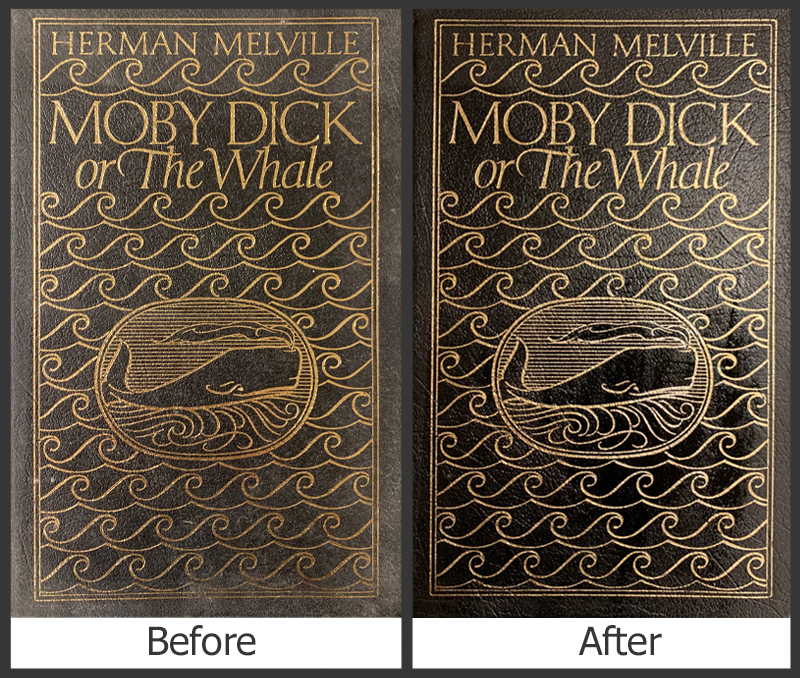
Dickens Repair: Great Expectations
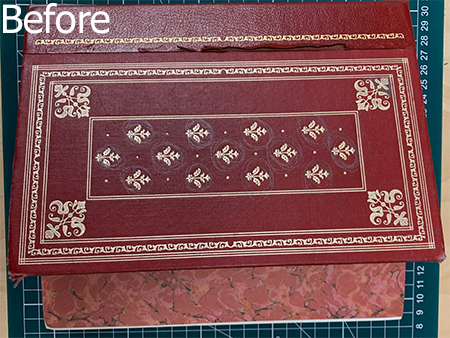
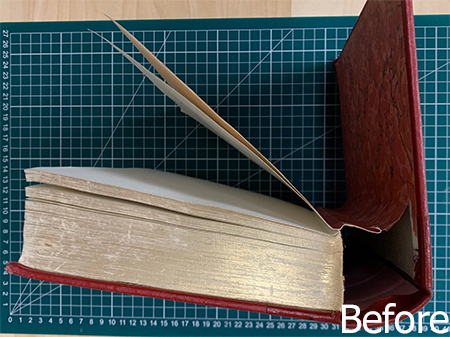
This edition of Charles Dickens' Great Expectations published by the Franklin Library is an example of the rather extensive repairs that can be needed. As the "Before Treatment" pictures above show, the volume was extremely damaged. The front hinge was severely loose; the front cover had pencil marks and a library sticker; the leather on the front cover had begun to peel; the fore edge corners were delaminating; and the volume no longer had its headband or satin page-marker. To restore this volume, I began by first removing the library stickers and erasing all the stray marks on the cover and in the text before re-gluing the peeling leather.
Next, I injected a combination of polyvinyl acetate and wheat starch paste into the corners of the front and back covers to reinforce them. Following this, I retrieved a satin page-marker from my collection of spare book parts, along with a headband that matched the endband. The page-marker was adhered to the spine with a PVA-wheat starch paste mixture, before an additional piece of super was placed on top of it; next the headband was adhered to the spine, over the additional super and page-marker. Once the adhesive in these repairs had dried, the final step involved tightening the front hinge with polyvinyl acetate. The result of these steps can be seen in the "After Treatment" photos below.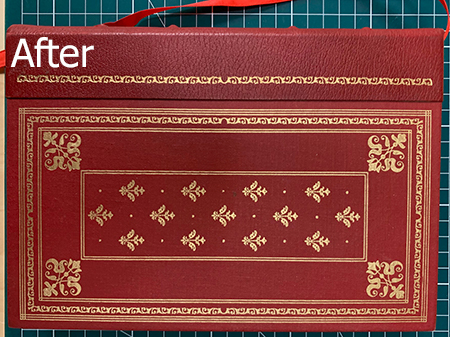
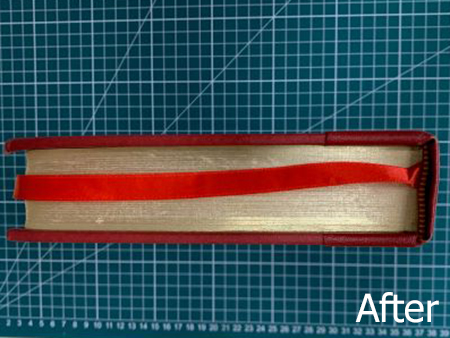
Preventing Damage
I'm often asked what can be done to prevent books from being damaged. There are some simple things that can be done. Keeping books shelved upright and firmly situated between other volumes will help prevent warping or damage to the base of the spine and covers. While safe storage is critical to maintaining the quality of your leather bound tomes, simply handling with uncovered hands can actually help as well. Exposure to the oils from human skin helps keep the leather in good, flexible condition. Another helpful tip for preventing damage is when retrieving a book from the shelf, always grasp the book by the middle of its spine, instead of reaching for the head of the spine. If you pull from the top, pressure is put on the turn-ins and the spine, leading to long term damage, particularly a loosening of the top hinges. By grasping the middle of the spine, the pressure is evenly distributed. Apart from these tips, a very simple thing you can do to preserve your books is simply to handle them with care.
See below for more examples of rare and collectible books Philip has restored:
- Anatomy of a Murder by Robert Traver
- Classic American Speeches
- Almost Up Devil's Tower by Mae Urbanek
- Arabian Nights
- Les Misérables by Victor Hugo
- Leaves of Grass by Walt Whitman
- Aristotle's Rhetoric and Poetics
Aubout the Author: Phillip Caprara is the Lead Vintage Receiver and Book Conservator for ThriftBooks Baltimore. After obtaining a BA in Classics from the University of North Carolina at Chapel Hill, he completed his MSt. in Classics from Oxford University with an emphasis on papyrology and a MA in Classics from Washington University in St. Louis where he worked extensively on papyrological conservation. When he finds the time to read, his favorite authors are Lucian of Samosata, Thomas Hardy, and Giuseppe Lampedusa.



